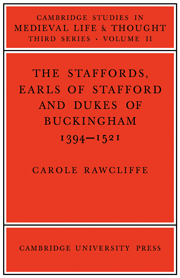Book contents
- Frontmatter
- Contents
- Dedication
- Acknowledgements
- Abbreviations
- Introduction
- 1 THE RISE OF THE STAFFORD FAMILY, 1343–1460
- 2 THE SECOND AND THIRD DUKES OF BUCKINGHAM, 1460–1521
- 3 THE MANAGEMENT OF THE STAFFORD ESTATES, 1438–1521
- 4 THE FIRST DUKE OF BUCKINGHAM'S HOUSEHOLD AND RETINUE, 1438–1460
- 5 CHANGES IN THE DUCAL LIFESTYLE, 1460–1521
- 6 THE FINANCES OF THE STAFFORDS, 14OO–1473
- 7 THE FINANCES OF THE STAFFORDS, 1473–1521
- 8 THE STAFFORDS AND THEIR COUNCIL
- 9 THE STAFFORDS AND THE COMMON LAW
- CONCLUSION
- APPENDICES
- Manuscript Sources
- Printed Sources
- Index
1 - THE RISE OF THE STAFFORD FAMILY, 1343–1460
Published online by Cambridge University Press: 07 October 2011
- Frontmatter
- Contents
- Dedication
- Acknowledgements
- Abbreviations
- Introduction
- 1 THE RISE OF THE STAFFORD FAMILY, 1343–1460
- 2 THE SECOND AND THIRD DUKES OF BUCKINGHAM, 1460–1521
- 3 THE MANAGEMENT OF THE STAFFORD ESTATES, 1438–1521
- 4 THE FIRST DUKE OF BUCKINGHAM'S HOUSEHOLD AND RETINUE, 1438–1460
- 5 CHANGES IN THE DUCAL LIFESTYLE, 1460–1521
- 6 THE FINANCES OF THE STAFFORDS, 14OO–1473
- 7 THE FINANCES OF THE STAFFORDS, 1473–1521
- 8 THE STAFFORDS AND THEIR COUNCIL
- 9 THE STAFFORDS AND THE COMMON LAW
- CONCLUSION
- APPENDICES
- Manuscript Sources
- Printed Sources
- Index
Summary
At the time of his attainder and execution in 1521, Edward Stafford, Duke of Buckingham, Earl of Stafford, Hereford and Northampton, Lord of Brecon and Holderness and heir general to both Edward III and Henry VI, held property worth over £6,000 a year gross. He and his ancestors had occupied many high offices, including the Constableships of England, Calais and France, and had served the Crown as councillors of state and captains of war. His estates were spread between Holderness in East Yorkshire and Newport in South Wales; he owned houses in Calais and possessed titles to lands in France and Ireland. Most of this great patrimony had been acquired in stages at the expense of other noble houses, which, being less fortunate than the Staffords, had failed to escape the disastrous consequences of attainder, dynastic failure and the accidents of war.
The early history of the Staffords was, however, undistinguished. Although the Norman knight Ralph de Tonei had been rewarded for his part in the conquest of England with a grant of more than one hundred confiscated manors, William I could never forget that Ralph's father had rebelled against him in Normandy, and had tempered his generosity with prudence by ensuring that these estates were scattered across England. Despite their claim to be titular lords of Stafford, Ralph's immediate descendants were prevented from controlling the town itself because they threatened to become too powerful along the Welsh March.
- Type
- Chapter
- Information
- The Staffords, Earls of Stafford and Dukes of Buckingham1394–1521, pp. 7 - 27Publisher: Cambridge University PressPrint publication year: 1978
- 1
- Cited by



